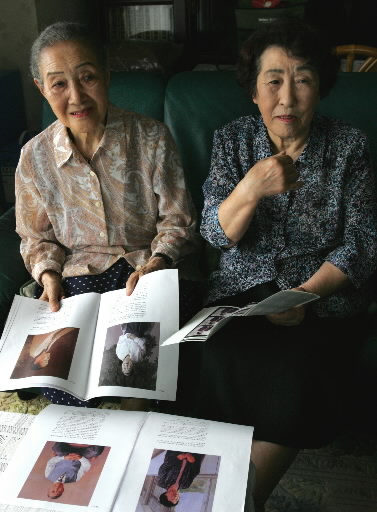Sharing the A-bomb Experience, Part 6
Aug. 3, 2009
Portrait reveals an aspiration for peace
by Kyosuke Mizukawa, Staff Writer
She suffered injuries to her legs, but “there are a lot of people whose experience was much worse than mine.” As a result, she hesitated to talk about the atomic bombing, feeling it would be presumptuous. Her four grandchildren have yet to hear her story.
Miyoko Kimura, 79, lives in downtown Hiroshima. Sixty-four years ago, when she was a fourth-year student at First Hiroshima Prefectural Girls’ High School, she was mobilized to work at the military’s Second General Headquarters, near the East Drill Ground. Her first day of work was set for August 7.
On the day before, she had no school and so she stayed at home, about 2.5 kilometers from the hypocenter. At 8:15 a.m. there was a flash in the sky and a great roar. Her house was tilted at an angle of “about 45 degrees” by the blast. As she was near a window, her legs were wounded by shattered glass. A soldier passing by took her hand and helped her flee with her family to an acquaintance’s house.
Several days later, she went back home and found that her house had managed to remain standing and had escaped the conflagration in the city. Her family then took in neighbors who had lost their homes or suffered injuries. In fact, the house became so full of people that Ms. Kimura was forced to turn down a classmate and her younger sister who came seeking help. The girl’s parents and home, located near the hypocenter, had perished in the bombing. Though Ms. Kimura was concerned about other classmates, too, the pain in her legs prevented her from leaving the house.
When school resumed in the fall of 1945 at a temporary school building in the suburbs, she learned the fate of about 50 students, serving as student nurses, who had been at the original school building in downtown Hiroshima at the time of the blast. Located about 600 meters from the hypocenter, the girls died almost instantly.
“Talking about it won’t bring anyone back,” she thought. Other schoolmates, mobilized at various sites, had survived the atomic bombing, too, but she never spoke about it with them.
After graduating from First Hiroshima Prefectural Girls’ High School, Ms. Kimura attended Hiroshima Prefectural College for Women (now, Hiroshima Prefectural University) for two years. Marriage then brought a son and daughter and she devoted herself to family life at their home near Peace Memorial Park. At the same time, she has never forgotten her friends whose lives were cut short. Each year she has paid tribute to them by taking part in the Peace Memorial Ceremony held on the anniversary of the bombing.
In 2006, Hisayo Bansho, 90, Ms. Kimura’s neighbor, who accompanied her to the annual ceremony for nearly ten years, told her, “It’s hard to find hibakusha around here anymore.” She said that art students at Hiroshima City University were working on portraits of atomic bomb survivors but were having difficulty finding models.
Ms. Kimura, also concerned about the falling number of survivors, decided to help the students with their project. “All I have to do is serve as their model,” she thought. When she visited the university campus, the students took nearly 30 photos of her displaying different expressions.
Moreover, the young people were eager to ask questions in the hope of “depicting the reality of the survivors’ emotions and lives.” Moved by their interest, she soon began to share her experience of the bombing. “I hope there will never be another atomic bombing or another war,” she told them. “That is my wish.” Ms. Kimura felt that she had finally spoken her mind.
Two years later, Ms. Kimura received a book of the student portraits, including her own. The portrait shows her looking through a window, out at the distant sky, and it made her clearly aware of her “aspiration for peace,” which she had not considered consciously until then.
“If asked, I want to share my A-bomb experience,” she said. For now, the book of portraits sits on a bookshelf, waiting to be opened by her grandchildren.
(Originally published on July 29, 2009)








